Graphene FET Sensors for Alzheimer’s Disease Protein Biomarker Clusterin Detection
| dc.contributor.author | Bungon, T | |
| dc.contributor.author | Haslam, C | |
| dc.contributor.author | Damiati, S | |
| dc.contributor.author | O’Driscoll, B | |
| dc.contributor.author | Whitley, T | |
| dc.contributor.author | Davey, Paul | |
| dc.contributor.author | Siligardi, G | |
| dc.contributor.author | Charmet, J | |
| dc.contributor.author | Awan, Shakil | |
| dc.date.accessioned | 2021-05-05T17:40:15Z | |
| dc.date.issued | 2021-03-26 | |
| dc.identifier.issn | 2296-889X | |
| dc.identifier.issn | 2296-889X | |
| dc.identifier.other | ARTN 651232 | |
| dc.identifier.uri | http://hdl.handle.net/10026.1/17086 | |
| dc.description.abstract |
<jats:p>We report on the fabrication and characterisation of graphene field-effect transistor (GFET) biosensors for the detection of Clusterin, a prominent protein biomarker of Alzheimer’s disease (AD). The GFET sensors were fabricated on Si/SiO<jats:sub>2</jats:sub> substrate using photolithographic patterning and metal lift-off techniques with evaporated chromium and sputtered gold contacts. Raman Spectroscopy was performed on the devices to determine the quality of the graphene. The GFETs were annealed to improve their performance before the channels were functionalized by immobilising the graphene surface with linker molecules and anti-Clusterin antibodies. Concentration of linker molecules was also independently verified by absorption spectroscopy using the highly collimated micro-beam light of Diamond B23 beamline. The detection was achieved through the binding reaction between the antibody and varying concentrations of Clusterin antigen from 1 to 100 pg/mL, as well as specificity tests using human chorionic gonadotropin (hCG), a glycoprotein risk biomarker of certain cancers. The GFETs were characterized using direct current (DC) 4-probe electrical resistance (4-PER) measurements, which demonstrated a limit of detection of the biosensors to be ∼ 300 fg/mL (4 fM). Comparison with back-gated Dirac voltage shifts with varying concentration of Clusterin show 4-PER measurements to be more accurate, at present, and point to a requirement for further optimisation of the fabrication processes for our next generation of GFET sensors. Thus, we have successfully fabricated a promising set of GFET biosensors for the detection of Clusterin protein biomarker. The developed GFET biosensors are entirely generic and also have the potential to be applied to a variety of other disease detection applications such as Parkinson’s, cancer, and cardiovascular.</jats:p> | |
| dc.format.extent | 651232- | |
| dc.format.medium | Electronic-eCollection | |
| dc.language | eng | |
| dc.language.iso | en | |
| dc.publisher | Frontiers Media SA | |
| dc.subject | graphene | |
| dc.subject | field-effect transistors | |
| dc.subject | biosensor | |
| dc.subject | Clusterin protein | |
| dc.subject | Alzheimer’ | |
| dc.subject | s disease | |
| dc.subject | SRCD absorbance spectroscopy | |
| dc.subject | DNA and molecular diagnostics | |
| dc.subject | cancer and cardiovascular disease detection | |
| dc.title | Graphene FET Sensors for Alzheimer’s Disease Protein Biomarker Clusterin Detection | |
| dc.type | journal-article | |
| dc.type | Journal Article | |
| plymouth.author-url | https://www.webofscience.com/api/gateway?GWVersion=2&SrcApp=PARTNER_APP&SrcAuth=LinksAMR&KeyUT=WOS:000639939000001&DestLinkType=FullRecord&DestApp=ALL_WOS&UsrCustomerID=11bb513d99f797142bcfeffcc58ea008 | |
| plymouth.volume | 8 | |
| plymouth.publication-status | Published online | |
| plymouth.journal | Frontiers in Molecular Biosciences | |
| dc.identifier.doi | 10.3389/fmolb.2021.651232 | |
| plymouth.organisational-group | /Plymouth | |
| plymouth.organisational-group | /Plymouth/Faculty of Science and Engineering | |
| plymouth.organisational-group | /Plymouth/Faculty of Science and Engineering/School of Engineering, Computing and Mathematics | |
| plymouth.organisational-group | /Plymouth/REF 2021 Researchers by UoA | |
| plymouth.organisational-group | /Plymouth/REF 2021 Researchers by UoA/UoA12 Engineering | |
| plymouth.organisational-group | /Plymouth/Users by role | |
| plymouth.organisational-group | /Plymouth/Users by role/Academics | |
| dc.publisher.place | Switzerland | |
| dcterms.dateAccepted | 2021-03-04 | |
| dc.rights.embargodate | 2021-5-14 | |
| dc.identifier.eissn | 2296-889X | |
| dc.rights.embargoperiod | Not known | |
| rioxxterms.funder | EPSRC | |
| rioxxterms.identifier.project | Novel Point-of-Care Diagnostic Techniques for Dementia | |
| rioxxterms.versionofrecord | 10.3389/fmolb.2021.651232 | |
| rioxxterms.licenseref.uri | http://www.rioxx.net/licenses/all-rights-reserved | |
| rioxxterms.licenseref.startdate | 2021-03-26 | |
| rioxxterms.type | Journal Article/Review | |
| plymouth.funder | Novel Point-of-Care Diagnostic Techniques for Dementia::EPSRC |


